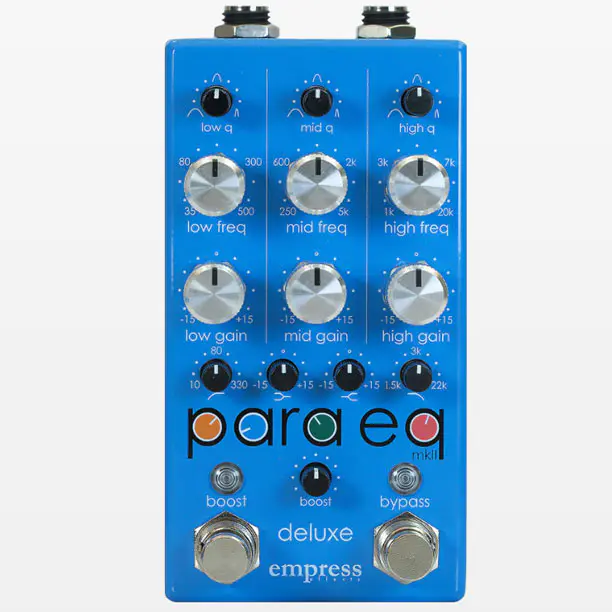
When we put together this article about the best EQ pedal earlier in 2022, we couldn’t believe how much interest there was in a discontinued pedal by Empress Effects, the ParaEQ, and wondered why it was out of production… enter the new Empress ParaEQ mkII and mkII Deluxe, two compact versions of the original, bound to take the EQ scene by storm!
While most guitarists are familiar with graphic EQ pedals like the BOSS GE-7, the ParaEQ is probably the best example of a console-style 3-band parametric EQ, which allows more control over just three selectable frequencies, allowing up to 15db of boost or cut.
So instead of just boosting or reducing pre-selected frequencies, with this pedal you can precisely select which frequency to boost within these ranges:
Bass: 35 Hz – 500 Hz
Mids: 250 Hz – 5k Hz
Highs: 1k Hz – 20 kHz
On top of that, just like in the top notch mixing consoles, the Q Toggle switches on top of each band allow to adjust the shape of the frequency cut/boost, with a skinny, precise shape, a medium one and a wider bell that will affect more frequencies around the selected one.
Just like the first edition, MkII also features a Boost knob and footswitch that can be useful to either recover some signal lost when cutting frequencies or to raise your volume during solos or louder parts.
There is also a more colorful Deluxe version of this pedal featuring these add ons:
- high-pass and low-pass filters
- Bandaxall (aka low and high shelf) filters for sparkling high-end or extra weight in the low end
- Continue Q selection through knobs rather than switches
Here’s how it looks:

We added this pedal to our article about the best EQ pedals (graphic and parametric) – check out the videos!
Empress ParaEQ MkII, Builder’s Notes
Parametric VS Graphic EQ Graph
Graphic equalizers provide a convenient visual sense of the EQ curve. However, there is a tradeoff in transparency and precision.The graph here shows the ParaEq MKII Deluxe (cyan) and a 7-band graphic EQ pedal (magenta) both providing a +4dB boost at around 2 kHz. As can be seen, the ParaEq is much more precise in the changes it can make, whereas the graphic EQ affects nearly the entire frequency spectrum. Furthermore, at around 10kHz the ParaEq is providing unity gain, whereas the graphic EQ is attenuating the signal by nearly 6dB. This makes the ParaEq a more transparent circuit than the graphic EQ.
This combination of transparency and precision is why recording studio control rooms are dominated by parametric equalizers, and why they’re a great choice for creative and corrective EQ on your pedalboard.
Which ParaEq Do You Need?
The original ParaEq has been loved and trusted by musicians on a variety of instruments for over a decade. Both the ParaEq MKII and the ParaEq MKII Deluxe feature a low-noise, transparent signal path that is extremely versatile.With three fully parametric bands, you can simultaneously achieve broad tonal shaping and precise fine-tuning to sculpt your perfect sound.
The ParaEQ MKII Deluxe will appeal to players who:
• Need high-pass and low-pass filters for precision work at the frequency extremes
• Want the glorious sound of Bandaxall filters for sparkling high end or extra weight in the low end
• Want to be prepared for any EQ situation






















